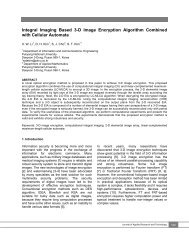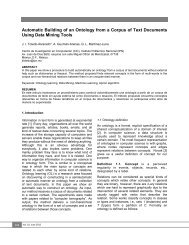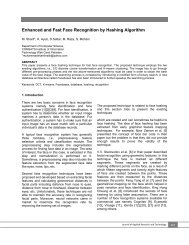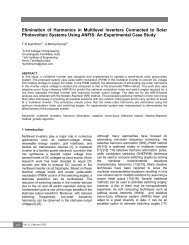Controller Design of STATCOM for Power System Stability ... - JART
Controller Design of STATCOM for Power System Stability ... - JART
Controller Design of STATCOM for Power System Stability ... - JART
You also want an ePaper? Increase the reach of your titles
YUMPU automatically turns print PDFs into web optimized ePapers that Google loves.
<strong>Controller</strong> <strong>Design</strong> <strong>of</strong> <strong>STATCOM</strong> <strong>for</strong> <strong>Power</strong> <strong>System</strong> <strong>Stability</strong>Improvement Using Honey Bee Mating OptimizationA. Safari *1 , A. Ahmadian 2 , M. A. A. Golkar 31Department <strong>of</strong> Electrical Engineering, Ahar Branch,Islamic Azad University, Ahar, Iran*a-safari@iau-ahar.ac.ir2, 3 The Electrical Engineering Department <strong>of</strong> K. N. ToosiUniversity <strong>of</strong> Technology, Tehran, IranABSTRACTDamping <strong>of</strong> low frequency electromechanical oscillations is very important <strong>for</strong> a safe system operation. The fastacting, <strong>of</strong> a static synchronous compensator (<strong>STATCOM</strong>) which is capable <strong>of</strong> improving both steady state anddynamic per<strong>for</strong>mance permits newer approaches to system stabilization. This paper presents a novel methodology <strong>for</strong>tuning <strong>STATCOM</strong> based damping controller in order to enhance the damping <strong>of</strong> system low frequency oscillations.The design <strong>of</strong> <strong>STATCOM</strong> parameters are considered an optimization problem according to the time domain-basedobjective function solved by a Honey Bee Mating Optimization (HBMO) algorithm that has a strong ability to find themost optimistic results. To validate the results accuracy, a comparison with Genetic Algorithm (GA) has been made.The effectiveness <strong>of</strong> the proposed controller is demonstrated through nonlinear time-domain simulation and someper<strong>for</strong>mance indices studies over a wide range <strong>of</strong> loading conditions. The simulation study shows that the designedcontroller by HBMO per<strong>for</strong>ms better than GA in finding the solution. Moreover, the system per<strong>for</strong>mance analysis underdifferent operating conditions shows that the φ based controller is superior to the C based controller.Keywords: <strong>STATCOM</strong>, honey bee mating optimization, power oscillation damping controller, low frequencyoscillations.NomenclatureDCE' qE fdFACTSFDGAGTOHBMOITAEKK AMP ePIP mPSOSMIB<strong>STATCOM</strong>SVCTADirect currentInternal voltage behind transientreactanceEquivalent excitation voltageFlexible alternating currenttransmission systemsFigure <strong>of</strong> demeritGenetic algorithmGate turn <strong>of</strong>f thyristorHoney bee mating optimizationIntegral <strong>of</strong> time multiplied absolutevalue <strong>of</strong> the errorProportional gain <strong>of</strong> the controllerRegulator gainMachine inertia coefficientElectrical output powerProportional integralMechanical input powerParticle swarm optimizationSingle machine infinite busStatic synchronous compensatorStatic var compensatorRegulator time constantT' doT eT sV dcVVSCδφ∆P e∆V dc1. IntroductionTime constant <strong>of</strong> excitation circuitElectric torqueSettling time <strong>of</strong> speed deviationDc capacitor voltageTerminal voltageVoltage source converterRotor speedRotor angleExcitation phase angleElectrical power deviationDC voltage deviationLeading in recent years, flexible alternativecurrent transmission systems (FACTS) devicesare one <strong>of</strong> the most effective ways to improvepower system operation controllability and powertransfer limits. Through the modulation <strong>of</strong> busvoltage, phase shift between buses, andtransmission line reactance, the FACTS devicescan cause a substantial increase in powertransfer limits during steady state [1]. Thesedevices are an addition to normally steady-statecontrol <strong>of</strong> a power system but, due to their fast144Vol. 11, February 2013
<strong>Controller</strong> <strong>Design</strong> <strong>of</strong> <strong>STATCOM</strong> <strong>for</strong> <strong>Power</strong> <strong>System</strong> <strong>Stability</strong> Improvement Using Honey Bee Mating Optimization, A. Safari et al. / 144‐155response, the FACTS can also be used <strong>for</strong> powersystem stability enhancement through improveddamping <strong>of</strong> power swings [2]. The real power flowwith primary function <strong>of</strong> FACTS devices can beregulated to reduce the low frequency oscillationand enhance power system stability. Recently,several FACTS devices have been implementedand installed in practical power systems [3-5].<strong>STATCOM</strong> is a member <strong>of</strong> the FACTS family thatis connected in shunt with the system. From theviewpoint <strong>of</strong> the power system dynamic stability,the <strong>STATCOM</strong> provides better dampingcharacteristics than the SVC. It is able toexchange transiently reactive power with thesystem, it can improve oscillation stability betterthan SVC [6, 7]. The <strong>STATCOM</strong> is based on theprinciple that a voltage source inverter generatesa controllable AC voltage source behind atrans<strong>for</strong>mer-leakage reactance hence, that thevoltage difference across the reactance canproduce active and reactive power exchangebetween the <strong>STATCOM</strong> and the transmissionnetwork. Several trials have been reported in theliterature <strong>of</strong> dynamic models <strong>of</strong> <strong>STATCOM</strong> inorder to design suitable controllers <strong>for</strong> power flow,voltage and damping controls [8]. Wang [9]established the linearized Phillips–Heffron model<strong>of</strong> a power system installed with a <strong>STATCOM</strong> anddemonstrated the application <strong>of</strong> the model inanalyzing the damping effect <strong>of</strong> the <strong>STATCOM</strong>.Furthermore, seems that no ef<strong>for</strong>ts have beenmade to identify the most suitable <strong>STATCOM</strong>control parameter, in order to arrive at a robustdamping controller. Intelligent controllers have thepotential <strong>of</strong> overcoming the above mentionedproblems. Fuzzy-logic-based controllers, <strong>for</strong>example, have been used <strong>for</strong> controlling a<strong>STATCOM</strong> [7, 10, 11]. The per<strong>for</strong>mance <strong>of</strong> suchcontrollers can be improved by adaptivelyupdating their parameters. Although using therobust control methods [12], the uncertainties aredirectly introduced to the synthesis. Due to thelarge model order <strong>of</strong> power systems, the orderresulting controller will be very large in generalwhich is not feasible because <strong>of</strong> the computationaleconomical problems when implementing. Thus,one important issue, in this respect, is the tuning<strong>of</strong> the controller parameters <strong>of</strong> the <strong>STATCOM</strong>. Forthis reason, usually a linearized model <strong>of</strong> thesystem around a single operation is used <strong>for</strong><strong>STATCOM</strong> controller design.Many <strong>of</strong> the optimization techniques such as PSO[13, 14], GA and HBMO are used <strong>for</strong> optimizationproblems. The HBMO algorithm can be used tosolve many <strong>of</strong> the same kind <strong>of</strong> problems as GA [15]and does not suffer from <strong>of</strong> GA’s problems. ThoughGA methods have been employed successfully tosolve complex optimization problems, a recentresearch has identified deficiencies on itsper<strong>for</strong>mance [16, 17]. In order to overcome thesedrawbacks, the HBMO algorithm is proposed tooptimal tune <strong>of</strong> controller parameters to improvepower system stability in this paper. The HBMOalgorithm is a very strong method <strong>for</strong> optimizationand has emerged as a useful tool <strong>for</strong> engineeringoptimization. Hence, this method is efficient inhandling large and complex search spaces [18, 19].In this study, the problem <strong>of</strong> designing a robustly<strong>STATCOM</strong> based damping controller is consideredas an optimization problem and both, HBMO and GAtechniques are used <strong>for</strong> searching optimizedparameters. The effectiveness and robustness <strong>of</strong> theproposed controller are demonstrated throughnonlinear time-domain simulation and someper<strong>for</strong>mance indices studying the damp lowfrequency oscillations under different operatingconditions. Evaluation results show that the HBMObased tuned damping controller achieved goodper<strong>for</strong>mance <strong>for</strong> a wide range <strong>of</strong> operating conditionsand is superior to the controller designed using GAtechnique.2. Honey bee mating optimizationThe honey bee is one <strong>of</strong> the social insects that onlycan survive as a member <strong>of</strong> a colony. The activity<strong>of</strong> honey bee suggests many characteristics suchas; team work and communication. A honey beecolony is normally compossed by a single egglayingqueen whose life-span is longer than that <strong>of</strong>any other bee; and depending on the season,regularly lays around 60,000 workers . A colonymay contain only one queen during its life-cycle.That is called monogynous. Only the queen is fedwith “royal jelly.” “Nurse bees” take care <strong>of</strong> thisgland and feed the queen with it. The royal jellyallows the queen bee to become the biggest bee inthe hive [20].Several hundred drones live with the queen andits workers. Queen bee’s life-span is about 5 or 6years, whereas <strong>for</strong> the rest <strong>of</strong> the bees, speciallyJournal <strong>of</strong> Applied Research and Technology 145
<strong>Controller</strong> <strong>Design</strong> <strong>of</strong> <strong>STATCOM</strong> <strong>for</strong> <strong>Power</strong> <strong>System</strong> <strong>Stability</strong> Improvement Using Honey Bee Mating Optimization, A. Safari et al. / 144‐155worker bees, their life-spam do not reach 1 year.The drones die after the mating process.The drones play the father role in the colony thatare haploid and amplify or multiply their mother’sgenome without changing their geneticcombinations, except <strong>for</strong> mutation. Hence, dronesare agents that anticipate one <strong>of</strong> the mother’sgametes and by the sake <strong>of</strong> that female can playgenetically the males´s role. Broods, cared byworkers, improve from fertilized or unfertilizedeggs. They represent potential queens andprospective drones, respectively. In the marriageprocess, the queens in mating period, fly from thenest to far places. Insemination ends with thegradual death <strong>of</strong> drones, and by the sake <strong>of</strong> thosequeens receive the “mating sign.” Any drone cantake part in the mating process just onece, but thequeens mate several times. These features makebee mating process very interesting among otherinsects.2. Working principle and mathematicalpresentationThe queen plays the most important role in themating process in nature likewise the HBMOalgorithm. The spermatheca is a place <strong>for</strong> sperm<strong>of</strong> drones and queen’s, all drones, however areoriginally haploid; after successful mating, thedrone’s sperm is stored in the queen’sspermatheca. A brood is reproduced by coming <strong>of</strong>some genes <strong>of</strong> drone’s into the brood genotype. Abrood has only one genotype [21].There<strong>for</strong>e, an HBMO algorithm would beconstructed by the following five important stages:1. The algorithm starts with a mating flight,where a queen selects dronesprobabilistically from the spermatheca. Adrone is selected from list randomly <strong>for</strong>the generating broods.2. Generating new broods by combiningdrone’s with queen´s genotypes .3. Using workers to carry on local searchingon broods.4. Adaptation <strong>of</strong> worker’s ability, based onthe improvement <strong>of</strong> broods.5. Substitution <strong>of</strong> queen’s workers bystronger and aptitude broods.When all queens have completed their matingflights, the breeding begins. All the broods afterthe generation are sorted according to fitness, i.e.their weakness or health. The best brood isreplaced by the worst queens until all queens willbe the best and there is no need <strong>of</strong> broods. Afterthe completion <strong>of</strong> mating, the remaining broodsfinally are killed hence, a new mating processbegins.2.2 Original HBMO algorithmA drone mates with a queen probabilistically usingan annealing function like this:Pr ob ( D , Q ) exp( f / S ( t ))(1)Where Prob(D,Q) is the probability <strong>of</strong> addingdrone’s sperm D to queen’s spermatheca Q, ∆(f)is the perfect difference <strong>of</strong> fitness D <strong>of</strong> queen, ands(t) is the speed <strong>of</strong> the queen at time t. Themating is high whether queen’s speed level ishigh, or drone’s fitness is equal to queen’s. Afterevery transition, the speed <strong>of</strong> queen will decreaseaccording to the following equations:s( t1) s( t)Et ( 1) Et ( ) (2)(3)Where: α is a factor ε(0,1) and γ is the amount <strong>of</strong>energy, E(t) reduction after each transition.The algorithm starts with three user-definedparameters and one predefined parameter. Thepredefined parameter is the number <strong>of</strong> workers (W),representing the number <strong>of</strong> heuristics encoded in theprogram. The three user-defined parameters are thenumber <strong>of</strong> queens, the queen’s spermatheca sizerepresenting the maximum number <strong>of</strong> mating perqueen in a single mating flight, and the number <strong>of</strong>broods that will be born by all queens. The energyand speed <strong>of</strong> each queen at the beginning <strong>of</strong> eachmating flight is initialized at random. A number <strong>of</strong>mating flights are realized. At the commencement <strong>of</strong>a mating flight, drones are generated randomly andthe queen selects a drone using the probabilistic rulein Equation (1). If the mating is done successfully,146Vol. 11, February 2013
<strong>Controller</strong> <strong>Design</strong> <strong>of</strong> <strong>STATCOM</strong> <strong>for</strong> <strong>Power</strong> <strong>System</strong> <strong>Stability</strong> Improvement Using Honey Bee Mating Optimization, A. Safari et al. / 144‐155the storage <strong>of</strong> drone’s sperm in queen’sspermatheca occurs. The combination <strong>of</strong> drone’sand queen’s genotypes, generate a new brood,which can be improved later on by employingworkers to carry on a local search. One <strong>of</strong> the maindifferences between HBMO algorithm and classicevolutionary algorithms is that by storing manydifferent drone’s sperm in the spermatheca <strong>for</strong> thequeen to use it , some <strong>of</strong> them create a new solution<strong>for</strong> the fittest broods, and gives the possibility tohave the fittest broods.The role <strong>of</strong> the workers is brood caring and <strong>for</strong> thesake <strong>of</strong> it, they are not separated from thepopulation and are used to grow the broodsgenerated by the queen. Every worker hasdifferent capability <strong>for</strong> producting in solutions. Thecomputational flow chart <strong>of</strong> HBMO algorithm isshown in Figure 1.startDefine the model input parameters:a) algorithm parameters, b) model parametersRandom generation <strong>of</strong> a set <strong>of</strong> initial solutionsRank the solutions based on the penalized objective function, keeping the bestone the predefined number <strong>of</strong> trial solutionsUse simulated annealing to select the set <strong>of</strong> solutions from the search space tomake a mating pool <strong>for</strong> possible in<strong>for</strong>mation exchange between the best presetsolution and the selected trial solutionsGenerate new set <strong>of</strong> solutions by employing different predefined crossoveroperators and heuristic functions between the best present solutions and the trialsolutions according to their fitness valuesImprove the newly generated set <strong>of</strong> solutions employing different heuristicfunctions and mutation operators according to their fitness valuesUpdating the fitness value <strong>of</strong> the heuristic functions <strong>for</strong> next iteration, giving morechance to the more effective heuristic function in solution improvementSubstitute thebest solutionYesIs the new bestsolution better thanthe previous one?NoKeep the previousbest solutionTerminationcriteria satisfiedYesFinishNoAll previous trial solutions are discarded and new trial solutions aregenerated using: a) remaining generated solution, b) randomgenerationFigure 1. Flowchart <strong>of</strong> the HBMO algorithm.Journal <strong>of</strong> Applied Research and Technology 147
<strong>Controller</strong> <strong>Design</strong> <strong>of</strong> <strong>STATCOM</strong> <strong>for</strong> <strong>Power</strong> <strong>System</strong> <strong>Stability</strong> Improvement Using Honey Bee Mating Optimization, A. Safari et al. / 144‐1553. <strong>Power</strong> system modelingA SMIB power system installed with a <strong>STATCOM</strong>shown in Figure 2, is widely used <strong>for</strong> studies <strong>of</strong>power system oscillations, it is adopted in thispaper to demonstrate the proposed method. Thesynchronous generator delivers power to theinfinite-bus through a double circuit transmissionline and a <strong>STATCOM</strong>. The system data is given inthe appendix. The system consists <strong>of</strong> a step downtrans<strong>for</strong>mer with a leakage reactance X SDT , athree phase GTO-based voltage source converter,and a DC capacitor [9].VtV EtL1VmL3Vbi Loq are the d-and q-components <strong>of</strong> the <strong>STATCOM</strong>current, respectively.The dynamics <strong>of</strong> the generator and the excitationsystem are expressed through a third order modelgiven as [9, 15]: ( 1)0(7). ( Pm Pe D)/M ,(8).Eq ( Eq E fd ) / Tdo ,(9)L2L4VSCf cV dc.E fd ( Efd Ka(VrefVt))/ Ta,(10)The expressions <strong>for</strong> the power output, terminalvoltage, and the d-q axes currents in thetransmission line and <strong>STATCOM</strong>, respectively, are:Figure 2. SMIB power system equippedwith <strong>STATCOM</strong>.The VSC generates a controllable AC voltagesource behind the leakage reactance. The voltagedifference between the <strong>STATCOM</strong> bus ACvoltage, v L(t) and v 0(t) produces active and reactivepower exchange between the <strong>STATCOM</strong> and thepower system, which can be controlled byadjusting the magnitude V 0 and the phase angleφ. The dynamic relation between the capacitorvoltage and current in the <strong>STATCOM</strong> circuit areexpressed as [9]:ILo (4)ILod jILoq,V o cVdc(cos j sin) cVdc,(5)IdccV dc ( ILodcos ILoqsin),CdcC(6)dcWhere <strong>for</strong> the PWM inverter c = mk and k is theratio between AC and DC voltage depending onthe inverter structure, m is the modulation ratiodefined by the PWM and the magnitude c is alsodefined by the PWM. The C dc is the dc capacitorvalue and I dc is the capacitor current while i Lod andX(1 LB X ) e LBq mVdcsinVbcosX SDT X SDTItld,X tL XX(1 LBtL X LB ) xdX LB X SDTX LB mVdccosVbsinX SDTItlq,X tL XX(1 LBtL X LB ) xqX LB X SDT(11)(12)eq ( xd X tL ) ItLq mVdcsinI Lod ,(13)X SDTmVdccos ( xd XtL)ItLqILoq,X SDTXtL(14)XLXL XT ; XLB ,(15)22X T , x' d and x q are the transmission line reactance,d-axis transient reactance, and q-axis reactance,respectively. A linear dynamic model is obtainedby linearizing the nonlinear model round anoperating condition.3.1 <strong>Power</strong> system linearized modelA linear dynamic model is obtained by linearizingthe nonlinear model around an operating148Vol. 11, February 2013
<strong>Controller</strong> <strong>Design</strong> <strong>of</strong> <strong>STATCOM</strong> <strong>for</strong> <strong>Power</strong> <strong>System</strong> <strong>Stability</strong> Improvement Using Honey Bee Mating Optimization, A. Safari et al. / 144‐155condition. The linearized model <strong>of</strong> power systemis given as follows:V DC (16) 0, ( P e D)/M ,(17)// Eq ( Eq Efd ) / Tdo,(18)∆ωPODV DCref∆u∆VKp dc K i dcsK s1 sTS∆φφ 0φE ( K ( v v) E )/ T(19)fd A ref fd AFigure 4. <strong>STATCOM</strong> PI controller <strong>for</strong> dc voltaje./vdc K7 K8Eq K9vdc K dcc K d, (20)V LrefV L/Pe K 1 K 2 Eq K pdc vdc(21) K pc c K p ,/Eq/K 4 K3Eq K qdc vdc K qcc K q, (22)/Vt K 5 K 6 Eq K vdc vdc(23) K vc c K v ,Where, K 1 ,K 2 ,...,K 9 , K pu , K qu and K vu are linearizationconstants. The state space model and blockdiagram <strong>of</strong> the linearized dynamic model <strong>of</strong> SMIBpower system with <strong>STATCOM</strong> is given by [15, 22].3.2 <strong>STATCOM</strong> based controllersThe POD controller, that is better than the PIDcontroller [23], is designed to produce an electricaltorque in phase with the speed deviationaccording to the phase compensation method.The speed deviation ∆ω is considered as theinput to the damping controller. The structure <strong>of</strong>the POD controller is given in Figure 3. Thiscontroller may be considered as a lead-lagcompensator. It comprises gain block, signalwashoutblock and lead-lag compensator. Theblock diagram <strong>of</strong> <strong>STATCOM</strong> dc voltage PIcontroller with power oscillation damping stabilizer(φ based controller) is shown in Figure 4. Setting<strong>of</strong> capacitor voltage is on the controlling part,which in relation to capacitor reference voltageand in comparison to the capacitor voltage, theamount <strong>of</strong> the angle phase <strong>of</strong> the converter canbe computed.InputsignalsT W 1sT 1 1 sT 3K1 sT W 1 sT 2 1 sT 4 Figure 3. <strong>Power</strong> oscillation damping controller.∆u∆ωFigure 5. <strong>STATCOM</strong> PI controller <strong>for</strong> ac voltaje.The DC-voltage regulator controls the DC voltageacross the DC capacitor <strong>of</strong> the <strong>STATCOM</strong>. Figure5 illustrates the block diagram <strong>of</strong> <strong>STATCOM</strong> acvoltage PI controller with a power oscillationdamping stabilizer (C based controller).3.3 <strong>STATCOM</strong> controllers design using HBMOIn the proposed method, we must tune the<strong>STATCOM</strong> controller parameters optimally toimprove overall system dynamic stability. The twosignal control <strong>of</strong> the <strong>STATCOM</strong> (φ and c) can bemodulated in order to produce the damping torque,since the selection <strong>of</strong> the parameter <strong>for</strong> <strong>STATCOM</strong>based damping controller is a complexoptimization problem. To acquire an optimalcombination, this paper employs the HBMO toimprove optimization synthesis and find the globaloptimum value <strong>of</strong> objective function. For ouroptimization problem, the objective function is atime domain-based objective function:J Np t sim i1 0POD. tdti∆u∆VKp ac K i acsK s1 sT(24)Where, the t sim is the time range <strong>of</strong> simulation andN p is the total number <strong>of</strong> operating points <strong>for</strong> whichthe optimization is carried out. It is aimed tominimize this objective function in order to improvethe system response in terms <strong>of</strong> the settling timeand overshoots. The design problem can beS∆cC 0cJournal <strong>of</strong> Applied Research and Technology 149
<strong>Controller</strong> <strong>Design</strong> <strong>of</strong> <strong>STATCOM</strong> <strong>for</strong> <strong>Power</strong> <strong>System</strong> <strong>Stability</strong> Improvement Using Honey Bee Mating Optimization, A. Safari et al. / 144‐155<strong>for</strong>mulated as the following constrained optimizationproblem, where the constraints are the controllerparameters bounds:Minimize J Subject to:minmaxG1 G1 G1minmaxG2 G2 G2minmaxG3 G3 G3minmaxG4 G4 G4minmaxG G G5 5 5The proposed approach employs HBMO to solvethis optimization problem and search <strong>for</strong> anoptimal set <strong>of</strong> controller parameters. Theoptimization <strong>of</strong> controller parameters are carriedout by evaluating the objective function as given inEquation 24, which considers a multiple <strong>of</strong>operating conditions. The operating conditions aregiven in Table 1.LoadingconditionP e (pu) Q e(pu) X LCase 1 0.8 0.15 0.3Case 2 0.2 0.01 0.3Case 3 1.2 0.4 0.3Case 4 0.5 0.1 0.6Case 5 0.9 0.1 0.6Case 6 0.5 -0.2 0.3Table 1. Loading conditionsType <strong>of</strong> controllerParametersHBMO algorithm Genetic algorithmC based φ based C based φ basedcontroller controller controller controllerK 95.692 181.44 169.55 181.23T 1 0.9154 0.13633 0.3811 0.3633T 2 0.3191 0.16796 0.930 0.6791T 3 0.0524 0.043 0.6622 0.1143T 4 0.6994 0.9368 0.2812 0.4466Kp dc --- 99.78 --- 105.23Ki dc --- 0.4762 --- 0.4851Kp ac 2.365 --- 1.48 ---Ki ac 0.0271 --- 0.099 ---Table 2. The optimal parameter settings <strong>of</strong> theproposed controllersIn order to acquire a better per<strong>for</strong>mance, thenumber <strong>of</strong> queen, N drone , N brood , the size <strong>of</strong> thequeen’s spermatheca, the decreasing factor andN workers are chosen as 1, 100, 100, 50, 0.98 and1000, respectively [21]. In order to facilitate thecomparison with genetic algorithm (see appendixB), the design and tuning <strong>of</strong> the dampingcontroller <strong>for</strong> <strong>STATCOM</strong> are used. The finalvalues <strong>of</strong> the optimized parameters with objectivefunction, J, are given in Table 2.4. Nonlinear time domain simulationIn this section, the per<strong>for</strong>mance <strong>of</strong> the proposedcontroller under transient conditions is verified byapplying a 6-cycle three-phase fault at t= 0.6 sec,at the middle <strong>of</strong> the L 3 transmission line. The faultis cleared by permanent tripping <strong>of</strong> the faultedline. The per<strong>for</strong>mance <strong>of</strong> the controllers when theHBMO is used in the design is compared to that <strong>of</strong>the controllers designed using the GA. Thesimulation results at all cases loading conditionsdue to designed controller based on the φ basedcontroller and C based controller are shown inFigures 6-11. It can be seen that the proposedcontroller has good per<strong>for</strong>mance in damping lowfrequency oscillations and stabilizes the systemquickly. Moreover, from the above conductedtests, it can be concluded that the φ basedcontroller is superior to the C based controller.To demonstrate per<strong>for</strong>mance and robustness <strong>of</strong>the proposed controller, two per<strong>for</strong>mance indices:ITAE and FD based on the system per<strong>for</strong>mancecharacteristics are defined as:ITAEt sim1000 . . t dt0(25)FD ( OS 500) ( US 2000) Ts2 2 2(26)Where, speed deviation (∆ω), Overshoot (OS),Undershoot (US) and settling time <strong>of</strong> speeddeviation <strong>of</strong> the machine is considered <strong>for</strong>evaluation <strong>of</strong> the ITAE and FD indices. It is worthto mention that, the lower the value <strong>of</strong> theseindices, the better the system response in terms<strong>of</strong> time-domain characteristics. Numerical results<strong>of</strong> the per<strong>for</strong>mance and robustness <strong>for</strong> all systemloading cases are shown in Figures 11 and 12. Itcan be seen that the application <strong>of</strong> both PSS and<strong>STATCOM</strong> damping controllers where the150Vol. 11, February 2013
<strong>Controller</strong> <strong>Design</strong> <strong>of</strong> <strong>STATCOM</strong> <strong>for</strong> <strong>Power</strong> <strong>System</strong> <strong>Stability</strong> Improvement Using Honey Bee Mating Optimization, A. Safari et al. / 144‐155controllers are tuned by the proposed coordinateddesign approach which gives the best response interms <strong>of</strong> overshoot, undershoot and settling time.5. ConclusionsThe honey bee mating optimization (HBMO)algorithm has been successfully applied to theoptimal design <strong>of</strong> <strong>STATCOM</strong> based dampingcontrollers. The design problem <strong>of</strong> the controller isconverted into an optimization problem which issolved by a HBMO technique with the time domainbasedobjective function. The robust design hasbeen found to be very effective <strong>for</strong> a range <strong>of</strong>operating conditions <strong>of</strong> the power system. Theeffectiveness <strong>of</strong> the proposed <strong>STATCOM</strong>controllers <strong>for</strong> improving transient stabilityper<strong>for</strong>mance <strong>of</strong> a power system are demonstratedby a weakly connected example system subjectedto severe disturbance. The system per<strong>for</strong>mancecharacteristics in terms <strong>of</strong> ITAE and FD indicesrevealed that using both, the proposed HBMO andthe GA based controllers, the overshoot, theundershoot ,the settling time and speed deviations<strong>of</strong> the machine are greatly reduced at variousoperating conditions. The nonlinear time domainsimulation results show the robustness <strong>of</strong> theproposed controller and their ability to provide gooddamping <strong>of</strong> low frequency oscillations. It can beseen that the HBMO based <strong>STATCOM</strong> controllerachieves good robust per<strong>for</strong>mance, providessuperior damping in comparison with the GA based<strong>STATCOM</strong> controller and greatly enhances thedynamic stability <strong>of</strong> power system. Moreover, theφ-based controller provides better dampingcharacteristics and greatly enhances the first swingstability compared to the C-based controller.(a) (b) (c)Figure 6. Dynamic responses <strong>for</strong> ∆ω at (a) case 1, (b) case 2, (c) case 3, loading conditions; solid (HBMObased C controller) and dashed (GA based C controller).(a)(b)Figure 7. Dynamic responses <strong>for</strong> ∆ω at (a) case 1, (b) case 2, (c) case 3 loading conditions; solid (HBMObased φ controller) and dashed (GA based φ controller).(c)Journal <strong>of</strong> Applied Research and Technology 151
<strong>Controller</strong> <strong>Design</strong> <strong>of</strong> <strong>STATCOM</strong> <strong>for</strong> <strong>Power</strong> <strong>System</strong> <strong>Stability</strong> Improvement Using Honey Bee Mating Optimization, A. Safari et al. / 144‐155(a) (b) (c) (d)Figure 8. Dynamic responses at case 1 loading; solid (HBMO <strong>Controller</strong>) and dashed (GA <strong>Controller</strong>); (a)∆Pe (C parameter), (b) ∆δ (C parameter), (c) ∆Pe (φ parameter) and (d) ∆δ (φ parameter).(a) (b) (c)Figure 9. Dynamic responses <strong>for</strong> ∆ω at (a) case 4, (b) case 5, (c) case 6 loading conditions; solid (HBMObased C controller) and dashed (GA based C controller).(a) (b) (c)Figure 10. Dynamic responses <strong>for</strong> ∆ω at (a) case 4, (b) case 5, (c) case 6 loading conditions; solid (HBMObased φ controller) and dashed (GA based φ controller).152Vol. 11, February 2013
<strong>Controller</strong> <strong>Design</strong> <strong>of</strong> <strong>STATCOM</strong> <strong>for</strong> <strong>Power</strong> <strong>System</strong> <strong>Stability</strong> Improvement Using Honey Bee Mating Optimization, A. Safari et al. / 144‐155(a)Figure 11. Value <strong>of</strong> per<strong>for</strong>mance index with C controller: a) ITAE and b) FD.(b)(a)(b)Figure 12. Value <strong>of</strong> per<strong>for</strong>mance index with φ controller: a) ITAE and b) FD.Appendix A:The nominal parameters <strong>of</strong> the system are listed inTable 3.M 8 MJ/MVA do 5 . 044GeneratorX d 1 puX q 0 . 6 p.u X d 0 . 3 pu D 0Excitation system K 50a T 0 . 05 saTrans<strong>for</strong>mers X 0.1puX SDT T 0 . 1 puTransmission lineX 0 . 4 puqDC link parameter V DC 1 pu C 1 p uDC<strong>STATCOM</strong> parameterC 0 .25 52K s = 1 T s = 0.05Table 3. <strong>System</strong> parameters.Appendix B:Genetic algorithms are stochastic searchtechniques based on the mechanism <strong>of</strong> naturalselection and survival <strong>of</strong> the fittest [23]. Further,they combine function evaluation with randomizedand/or well-structured exchange <strong>of</strong> in<strong>for</strong>mationamong solutions to arrive at global optimum. Thearchitecture <strong>of</strong> GA implementation can besegregated into three constituent phases namely:initial population generation, fitness evaluation andgenetic operations. The GA control parameters,such as population size, crossover probability andmutation probability are selected, and an initialpopulation <strong>of</strong> binary strings <strong>of</strong> finite length isJournal <strong>of</strong> Applied Research and Technology 153
<strong>Controller</strong> <strong>Design</strong> <strong>of</strong> <strong>STATCOM</strong> <strong>for</strong> <strong>Power</strong> <strong>System</strong> <strong>Stability</strong> Improvement Using Honey Bee Mating Optimization, A. Safari et al. / 144‐155randomly generated. Given a random initialpopulation GA operates in cycles calledgenerations, as follows [25]:- Each member <strong>of</strong> the population is evaluatedusing a fitness function.- The population undergoes reproduction in anumber <strong>of</strong> iterations. One or more parents arechosen stochastically, but strings with higherfitness values have higher probability <strong>of</strong>contributing with an <strong>of</strong>fspring.- Genetic operators, such as crossover andmutation are applied to parents to produce <strong>of</strong>fspring.- The <strong>of</strong>fspring are inserted into the population andthe process is repeated.The crossover is the kernel <strong>of</strong> genetic operations.It promotes the exploration <strong>of</strong> new regions in thesearch space using randomized mechanism <strong>of</strong>exchanging in<strong>for</strong>mation between strings. Twoindividuals placed in the mating pool duringreproduction are randomly selected. A crossoverpoint is then randomly selected and in<strong>for</strong>mationfrom one parent up to the crossover point isexchanged with the other parent. Theper<strong>for</strong>mance method is illustrated below <strong>for</strong> theused simple crossover technique.Parent 1: 1011↓ 1110 <strong>of</strong>fspring 1: 10111011startSpecify the parameters <strong>for</strong>GAGenerate the initiall tiGen=1Calculate the fitness value <strong>of</strong>each individualGen > MaxGenYesOptimal value <strong>of</strong> thecontroller parameterFinishNoGen = Gen+1Apply GA operations:selection, crossoverand mutationParent 2: 1010 ↓1011 <strong>of</strong>fspring 2: 1010 1110Another process also considered in this work is themutation process <strong>of</strong> randomly changing encodedbit in<strong>for</strong>mation <strong>for</strong> a newly created populationindividual. Mutation is generally considered as asecondary operator to extend the search spaceand cause escape from a local optimum whenused prudently with the selection and crossoverschemes. For the purpose <strong>of</strong> optimization <strong>of</strong>Equation 24. routine from GA [24] is used.Using each set <strong>of</strong> controller parameters, the timedomain simulation is per<strong>for</strong>med and the fitnessfunction value is determined. The computationalflow chart <strong>of</strong> GA algorithm is shown in Figure 13.While applying GA, a number <strong>of</strong> parameters arerequired to be specified. Optimization is terminatedby the pre-specified number <strong>of</strong> generations <strong>for</strong>genetic algorithm.Figure 13. Flowchart <strong>of</strong> the genetic Algorithm.AcknowledgementsThe authors would like to thank the anonymousreviewers <strong>for</strong> their helpful criticisms and suggestions <strong>for</strong>improving the earlier version <strong>of</strong> this paper.References[1] A.T. Al-Awami et al., A particle-swarm based approach<strong>of</strong> power system stability enhancement with unified powerflow controller, International Journal <strong>of</strong> Electrical <strong>Power</strong> andEnergy <strong>System</strong>, Vol. 29, pp. 251-259, 2007.[2] J. Machowski and J. W. Bialek, State variable control <strong>of</strong>shunt FACTS devices using phasor measurements, Electric<strong>Power</strong> <strong>System</strong>s Research, Vol. 78, pp. 39-4, 2008.[3] A. E. Hammad, Analysis <strong>of</strong> power system stabilityenhancement by static VAR compensators, IEEETransaction. <strong>Power</strong> <strong>System</strong>, No.4, pp. 222- 227, 1986.154Vol. 11, February 2013
<strong>Controller</strong> <strong>Design</strong> <strong>of</strong> <strong>STATCOM</strong> <strong>for</strong> <strong>Power</strong> <strong>System</strong> <strong>Stability</strong> Improvement Using Honey Bee Mating Optimization, A. Safari et al. / 144‐155[4] M. Noroozian and G. Anderson, Damping <strong>of</strong> powersystem oscillations by use <strong>of</strong> controllable components,IEEE Transaction <strong>Power</strong> Delivery Vol. 9, pp. 2046-2054, 1994.[5] M. A. Abido and Y. L. Abdel-Magid, Analysis and<strong>Design</strong> <strong>of</strong> power system stabilizers and FACTS basedstabilizers using genetic algorithms, in: Proceedings <strong>of</strong>the 14th power system computation conference PSCC-,Session 14, Paper 4, Seville, Spain, 2002, June 24-28.[6] N. Mithulanathan, et al., Comparison <strong>of</strong> PSS, SVCand <strong>STATCOM</strong> controllers <strong>for</strong> damping power systemsoscillations, IEEE Transaction. <strong>Power</strong> <strong>System</strong>, Vol. 18,pp.786-792, 2003.[7] S. Morris, et al., A fuzzy variable structure controller<strong>for</strong> <strong>STATCOM</strong>, Electric <strong>Power</strong> <strong>System</strong>s Research, Vol.65, pp. 23-34, 2003.[8] N. G. Hingorani and L. Gyugyi, UnderstandingFACTS: concepts and technology <strong>of</strong> flexible ACtransmission systems, Wiley-IEEE Press, 1999.[9] H. F. Wang, Phillips-Heffron model <strong>of</strong> power systemsinstalled with <strong>STATCOM</strong> and applications, IEE Proc. onGeneration Transmission and Distribution, Vol. 146, pp.521-527, 1999.[10] A. Safari and H. Shayeghi, Optimal design <strong>of</strong> UPFCbased damping controller using iteration PSO, Worldacademy <strong>of</strong> science, Engieering and technology, Vol. 52,pp. 709-714, 2009.[11] A. Safari, et al., A chaotic optimization algorithm tooutput feedback damping controller design <strong>for</strong> a<strong>STATCOM</strong>, International Journal on technical andphysical problems <strong>of</strong> engineering, Vol. 1,pp.44-50, 2010.[12] A. H. M. A. Rahim and M. F. Kandlawala, Robust<strong>STATCOM</strong> voltage controller design using loop shapingtechnique, Electric <strong>Power</strong> <strong>System</strong>s Research, Vol. 68,pp. 61-74, 2004.[13] A. L. Gerardo, et al., Comparative Study <strong>of</strong> ParallelVariants <strong>for</strong> a Particle Swarm Optimization AlgorithmImplemented on a Multithreading GPU, Journal Applied<strong>of</strong> Research and Technology (<strong>JART</strong>), Vol.7, pp. 292-309, 2009.[14] H. Rezazadeh, et al., Linear programmingembedded particle swarm optimization <strong>for</strong> solving anextended model <strong>of</strong> dynamic virtual cellularmanufacturing systems, Journal Applied <strong>of</strong> Researchand Technology (<strong>JART</strong>), Vol.7, pp. 83-108, 2009.[15] M. A. Abido, Analysis and assessment <strong>of</strong><strong>STATCOM</strong> based damping stabilizers <strong>for</strong> power systemstability enhancement, Electric <strong>Power</strong> <strong>System</strong>sResearch, Vol. 73, pp. 177-185, 2005.[16] R. C. Eberhart and Y. Shi, Comparison betweengenetic algorithms and particle swarm optimization, inIEEE International Conference EvolutionaryComputation, May 1998, pp. 611–616.[17] D. B. Fogel, Evolutionary Computation: Toward aNew Philosophy <strong>of</strong> Machine Intelligence, 2ed.Piscataway, NJ: IEEE Press, 2000.[18] C. Zhang, et al., An Artificial Bee Colony Approach<strong>for</strong> Clustering, Expert <strong>System</strong>s with Applications, Vol. 37,pp. 4761-4767, 2010.[19] O.B. Haddad et al. Honey bee mating optimization(HBMO) algorithm, A new Heuristic approach <strong>for</strong> waterresources optimization, Water Resources Management,Vol. 20, pp. 661-680, 2006.[20] A. Afshar, et al., Honey bee mating optimization(HBMO) algorithm <strong>for</strong> optimal reservoir operation,Journal <strong>of</strong> Franklin Institute, Vol. 344, pp. 452- 462,2007.[21] T. Niknam, et al., A new honey bee matingoptimization algorithm <strong>for</strong> non-smooth economicdispatch, Energy, Vol. 36, pp. 896-908, 2011.[22] M. A. Golkar and M., Zarringhalami, Coordinated<strong>Design</strong> <strong>of</strong> PSS and <strong>STATCOM</strong> Parameters <strong>for</strong> <strong>Power</strong><strong>System</strong> <strong>Stability</strong> Improvement Using Genetic Algorithm,Iranian Journal <strong>of</strong> Electrical and Computer Engineering,Vol. 8, pp. 80-88, 2009.[23] D. Rosas, et al., control <strong>of</strong> a saddle node bifurcationin a power system using a PID controller, JournalApplied <strong>of</strong> Research and Technology (<strong>JART</strong>), Vol.1, pp.94-102, 2003.[24] D. A. Coley, An introduction to genetic algorithms<strong>for</strong> scientists and engineers, World Scientific PublishingCo, 1999.[25] D. E. Goldberg, Genetic Algorithms in Search,Optimization and Machine Learning, Addison Wesley,1989.Journal <strong>of</strong> Applied Research and Technology 155







